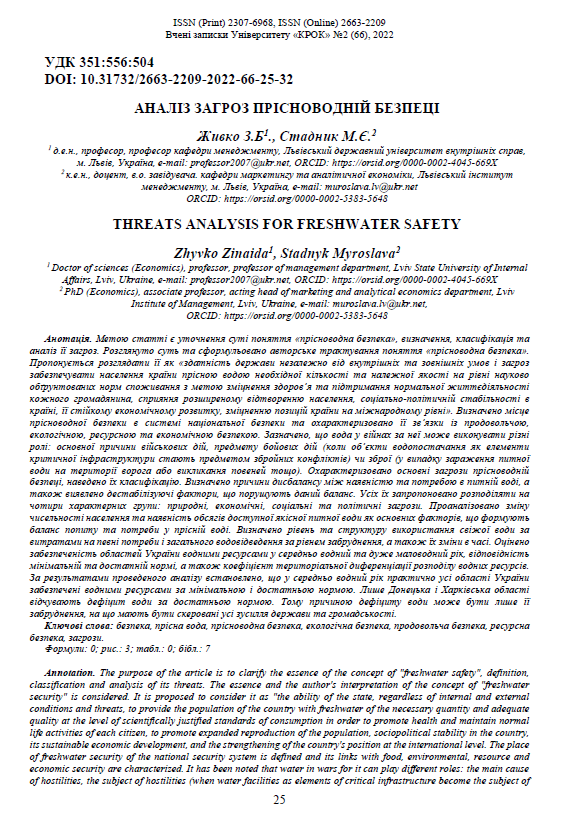THREATS ANALYSIS FOR FRESHWATER SAFETY
DOI:
https://doi.org/10.31732/2663-2209-2022-66-25-32Keywords:
security, fresh water, freshwater security, environmental security, food security, resource security, threatsAbstract
The purpose of the article is to clarify the essence of the concept of "freshwater safety", definition, classification and analysis of its threats. The essence and the author's interpretation of the concept of "freshwater security" is considered. It is proposed to consider it as "the ability of the state, regardless of internal and external conditions and threats, to provide the population of the country with freshwater of the necessary quantity and adequate quality at the level of scientifically justified standards of consumption in order to promote health and maintain normal life activities of each citizen, to promote expanded reproduction of the population, sociopolitical stability in the country, its sustainable economic development, and the strengthening of the country's position at the international level. The place of freshwater security of the national security system is defined and its links with food, environmental, resource and economic security are characterized. It has been noted that water in wars for it can play different roles: the main cause of hostilities, the subject of hostilities (when water facilities as elements of critical infrastructure become the subject of armed conflicts) or weapons (in the case of contamination of drinking water in the enemy's territory or flooding of the like). The main threats to freshwater security are characterized and their classification is given. Causes of imbalance between water availability and water demand are determined and destabilizing factors disturbing this balance are identified. All of them are proposed to be divided into four characteristic groups: natural, economic, social and political threats. Changes in the population and the availability of available quality drinking water as the main factors forming the balance of demand and demand for freshwater were analyzed. The level and structure of fresh water use by expenditures for certain needs and total drainage by the level of pollution, as well as their changes over time, were determined. The availability of water resources in Ukrainian provinces in average water year and low water year, compliance with minimum and sufficient norm, as well as the coefficient of territorial differentiation of water resources distribution is assessed. According to the results of the analysis, it was established that practically all provinces of Ukraine are provided with water resources according to the minimum and sufficient norms in the average water year. Only Donetsk and Kharkiv regions experience water deficit by sufficient norm. Therefore, the cause of water shortage can only be pollution, which should be the focus of all efforts of the state and the public.
Downloads
References
Стадник М. Є., Хомин О. Й. Зміцнення демографічної безпеки через призму екологізації водозабезпечення. Економічна безпека в умовах глобалізації світової економіки : колективна монографія у 2 т. Дніпропетровськ : «ФОП Дробязко С. І.», 2014. Т.1. С. 224-232.
Стадник М. Є. Прісноводна безпека : суть, загрози та способи їх подолання. Науковий вісник Львівського державного університету внутрішніх справ. Серія економічна. 2010. № 2. С. 145-155.
Пастернак-Таранушенко Г. Економічна безпека держави. Статистика процесу забезпечення : підручник для держ. службовців, науковців, студентів і аспірантів вищих навч. закладів ек. профілю / за ред. проф. Б. Кравченка. Київ : Кондор, 2002. 302 с.
Комарницький І. М., Франів І. А., Комарницький Б. М. Проблеми забезпечення економічної безпеки держави. Торгівля і ринок України. 2010. Вип. 29. С. 332-338.
Юридичний словник-довідник. URL: https://subject.com.ua/pravo/dict/345.html.
Стадник М. Є., Стадник О. В. Класифікація загроз прісноводній безпеці. Науковий вісник Львівського державного університету внутрішніх справ. Серія економічна. 2015. В.2. С. 150-160.
Державна служба статистики України. URL: http://www.ukrstat.gov.ua/

Downloads
Published
How to Cite
Issue
Section
License
Copyright (c) 2022 Zhyvko Zinaida, Stadnyk Myroslava

This work is licensed under a Creative Commons Attribution 4.0 International License.

